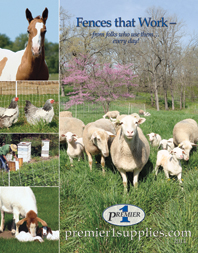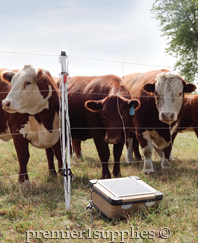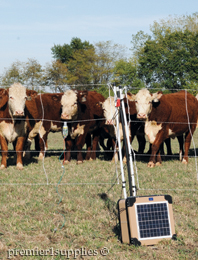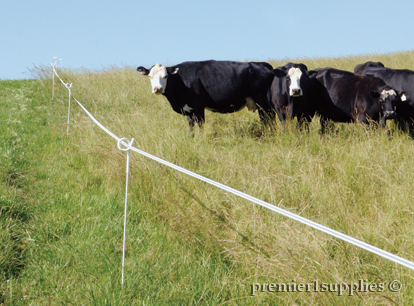NEW! FENCES THAT WORK BOOKLET
 New!
New!
2014 Fence Booklet
Look for it in your mailbox the week of March 17. It includes, along with our standard products, the following new items:
HotShock® & IntelliShock® Energizers
(Expected mid-April 2014.)
Low cost, new design! 0.5, 1, 2 and 3 joule units that use either battery or plug-in power. IntelliShock DC units are variable draw—which means they use less energy when the fence is clean, thus increasing battery life and reducing cost.
Insulators
| • |
Corner Roller—Prevents conductor from slipping off. Smooth roller prevents wear on conductors. Safer—plastic pin breaks if a horse crashes into fence. |
| • |
Double Pigtail Offset—Holds conductors on opposite sides of wooden post. For use with rope and narrow tape. Tolerates moderate up/down strain. |
Stainless Steel Spring Gate
New stainless steel option. This gate is popular and effective. It fully retracts when expanded. Uncoiled spring measures 16 ft.
PREMIER NETTING

Users like Cattle QuikFence™ because it's so fast and easy to install/remove—and because it's very effective for cows, calves, bulls, heifers and steers. Conductors are 3/16" thick for enhanced visibility.
Semi-Permanent Cattle QuikFence™
Premier is the source of 80% of the USA's electric netting. And we're the world leader for new netting designs and uses!
Why Premier “knows” netting...
| • |
We’ve used it for 44 years (since 1970)—longer than anyone in the US. |
| • |
It’s in use 24/7 at Premier to fence sheep, goats, poultry and dogs in—and to fence deer, coyotes, and stray dogs out. |
| • |
We talk daily to netting users nationwide—who let us know what they like and/or dislike; when it works and when and why it doesn’t. |
| • |
View our Netting Comparison Chart to compare all of our nets. |
We have 3 netting videos available:
ENERGIZERS
PRS Solar Energizers

PRS energizers have enough power to deter cattle from wandering to greener pastures.
|
Which unit is right for you?
The size, in pulse energy output (range from .5 joule to 2 joules), depends almost entirely on the weed contact that will occur and the length of the fence.
Contact Premier or call 800-282-6631 to speak with one of our fence consultants to help you determine the best energizer for your needs. We have a unique 2-year rapid replacement warranty on all of our energizers.
You can also view our energizer comparison charts online or in Premier's fencing booklet to help in choosing an energizer.
|
 |
 |

For most cattle one strand of tape (or rope) is enough for a subdivision fence. Set conductor height at or below nose level.
Before you buy or build a fence
Q. What is the fence’s location? Is it flat? Or does it go over hills and ditches and around curves? Is it covered with brush, trees or open grass? Are the soils rocky, very soft, sandy or firm?
A.The optimum fence design often hinges on answers to these questions.
Q. Do the animals know the fence?
A. Local animals and wildlife get to “know” a fence by appearance, location and “pain memory.” If it’s a strong or painful fence they avoid it. On the other hand new animals just off a truck often charge into permanent fences and straight through temporary or semi-permanent fences. That’s why strong, tall, visible permanent fences are essential for corrals and feedlots. Temporary fences that are not physically strong pose the greatest risk of escape to newly acquired animals. It pays to train them to it inside of a permanent fence.
Q. What specific animals need to be fenced in or out?
A. Always design and build for the most difficult species. Rules of thumb:
| • |
Most sheep and goat fences will stop cattle and horses. The inverse is not always true. |
| • |
Fencing adult males (bulls, rams, stallions, billies) in/out during breeding season requires taller fences with closer wire/strand spacing and more powerful electric pulses (in joules, not volts). |
| • |
Fences for mixed sizes (ewes with lambs, etc.) need more strands than uniform animal groups. |
| • |
Certain breeds need better fences (e.g. flighty Romanov sheep, tall Columbia sheep, Chianina cattle). |
Q. Should you energize the fence?
A. It pays to do this. Why?
| • |
A “hot” strand has a “zone of pain.” So fewer strands are needed if one is energized. Both the material and the labor to install is reduced. |
| • |
Energized fences last longer and require less maintenance—because animals do not crowd, rub or scratch on them. So the fence wires (including wires that are not energized) require less tension to do their job. And braces and corner posts will last longer. |
| • |
Animals are more surely contained or excluded during breeding and weaning. |
Q. How keen will animals be to breach the fence line?
A. Build for the worst-case situation (if you can afford to do so).
| • |
Hunger. Starved animals will eventually challenge most fences. |
| • |
Weaning. Strong physical barriers are needed. |
| • |
Breeding. Libido induces all creatures to challenge rules and especially fences. |
| • |
Boredom. Animals in corrals, stalls and feedlots crave any “entertainment” or activity. |
| • |
Gateways and handling yards. Animals often push each other into fences when being moved. |
| • |
Fear and fright. Predators or loud noises can cause “prey” species (e.g. horses, goats, turkeys) to run in terror straight into, under, over or through any fence, no matter what fence design (netting, high-tensile or woven wire). |
CATTLE FENCE OPTIONS

Fence Solutions for Cattle
Cattle fence systems available:
| • |
Temporary (far left photo) — Reel-Based |
| • |
Semi-Permanent (middle photo) — Cattle QuikFence & Rope |
| • |
Permanent (far right photo) — Hi-Tensile Smooth Wire, Combo (Smooth & Woven) and Barbed Wire |
Why electric cattle fences work so well for so many...
| • |
Because cattle are sensitive to electric shock. Why? Short hair coat (in summer), heavy body, large hooves—so they’re low-resistance animals (compared to goats and deer). |
| • |
The lowest “live” wire can be 2 ft above the ground. Result: Energy loss from any grass-to-wire contact is much less. |
| • |
Their frontal eye placement allows them to see low-visibility fences more readily than horses or deer. |
| • |
Their heavy body weight ensures very good hoof-to-soil contact. |
| • |
Few predators. So low fence wires to deter predators are very seldom necessary. Again less weed to “live” wire contact. |
| • |
Most (but not all) cattle walk instead of run, giving them time to see fences. |
Combine these factors and you have an animal that’s more easily controlled by electric fences.
For better results use...
| • |
Wide-impedance energizers: Superior to low-impedance units when the soil is dry and grass is brown. |
| • |
IntelliShock® battery energizers: They sense when a fence is “clean” of weeds and automatically respond by using up to 65% less battery energy. |
| • |
IntelliRope, twine and tape: They’re more conductive, visible and durable than conductors found in farmstores. |
| • |
EzeReels™: Have extra capacity to store bulky rope and tape. |
| • |
Insulators built extra-strong so you can forget about them once installed. |
Why some fences disappoint...
An electric fence is a system. It’s only as good as its weakest link. All parts (posts, conductors, energizer, ground rods) of the system must be durable and effective.
Probable reasons for problems with electric cattle fences...
| • |
Reliance on farmstore solar energizers. They often promise much and deliver little. Their energy output is small—and can soon become “zero” when weeds touch the fence. |
| • |
Modern low-impedance energizers work fine when the grass is green, but their output in joules drops quickly when the soil is dry and the grass is brown. |
| • |
Polywires and polytape that lack adequate visibility, conductivity and/or durability. |
| • |
Using posts and insulators that are prone to fail. The cheapest is not always the least expensive. Unfortunately, price competition by some firms that supply farmstores has resulted in a percentage of products whose claim to fame is that they cost less—not that they work well in real-time conditions. |
| • |
Frustrating windup reels (or none at all)! |
| • |
Low conductivity. |
|
|